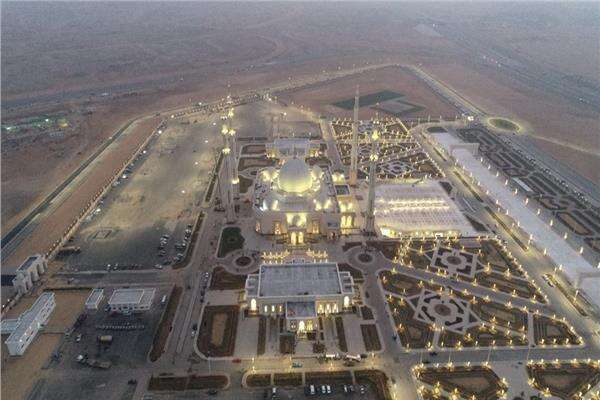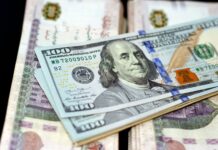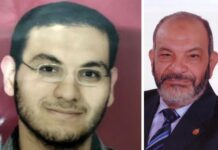In March 2015, during Abdel Fattah Al-Sisi’s meeting with the Emirati Prime Minister and ruler of Dubai, Sheikh Muhammad bin Rashid Al Maktoum, in the Egyptian city of Sharm El-Sheikh, the establishment of the New Administrative Capital was announced.
This capital will be the nucleus for the relocation of ministries, embassies, and strategic sites in Cairo in a remote location in the depths of the Eastern Desert, close to Suez, as the future capital of Egypt.
In this announcement, Al-Sisi asked one of the project’s executors, the Emirati businessman and head of Emaar, Muhammad Al-Abbar, about the expected period to complete the project, and he replied that the scheduled period is 10 years. This answer inspired Al-Sisi to respond with excitement: “No, 7,” which means that the man was and is still eager to complete his city’s construction in the shortest and fastest period.
A few days ago, Al-Sisi considered the Administrative Capital project’s opening, which will take place at the end of this year, as a “declaration of a new republic” in his country. This came in conjunction with a Reuters report that revealed that the first phase of establishing the administrative capital cost $25 billion, which was provided through loans and foreign financing. And here lies the more difficult question: How will the administrative capital and Al-Sisi’s various projects reflect on Egyptians’ livelihood?
Economist Mustafa Shaheen says that all real estate projects that are taking place now in Egypt, including the New Administrative Capital, will not serve the simple Egyptian citizen, nor will they make a difference to his income. He adds, “Regarding the economic aspect: all new real estate projects will not increase the average person’s income level.” He continues: “On the other hand, if closed factories are opened throughout the republic, such as spinning and weaving factories in Mahalla, Menoufia, Dakahlia, and an iron and steel factory in Helwan, this will make a big change in the lives of large sectors of people.”
He explains that without the productive strength of the Egyptian economy, it will not be able to last for long, and what happens in the New Administrative Capital, in addition to the government’s daily decisions regarding imposing taxes and fees on large sectors of the people, burdens the average citizen. He continues, “The regime built a railway in the Administrative Capital at a cost of $3 billion, so why is the same amount not allocated to closed factories or a loan taken for it? The economy is not only services but is based on production.”
Shaheen went on, saying that the luxury real estate projects in the Administrative Capital and elsewhere would cause a class struggle in society, which would inevitably lead to more tension on the economic and political levels. He stressed: “The state’s interest in the countryside, regions and Upper Egypt should be reflected in its general budget, as here there are the highest rates of poverty in Egypt.”
Journalist Salim Azouz agrees with him and says that the Administrative Capital project “represents a safe haven for the escape of members of the ruling class in Egypt by moving government and security headquarters to it.” He explains that the wealth of the Egyptians is being squandered because Al-Sisi deals with state lands as his private property.
Azouz wonders about the economic return that guarantees the payment of the absence of production and the weakness of the export capacity, which may lead to an anticipated liquidity crisis in the country. He says that Cairo will remain the capital of the country, denouncing the construction of useless buildings that cost billions. Azouz mentioned the interfaith complex, which includes the Al-Fattah Al-Alim Mosque, which is the largest religious edifice in the Middle East at 250,000 metres and accommodates about 12,000 worshipers, in a place that no one lives.
Although the state keeps its costs a secret, unofficial statements fluctuated between EGP 400 million and EGP one billion. The cost of the New Administrative Capital cathedral also reached EGP 400 million. Work also began with casting the concrete foundations for 80 continuous hours for the tower, which is being implemented by the Chinese company CSCEC, and was designed in the form of a Pharaonic obelisk. Its length reaches 1,000 metres, higher than the Burj Khalifa in Dubai.
The government did not offer information about the tower’s costs. But according to a high-level source, Chinese banks are providing an 85 per cent loan to the project, whose total cost reaches $3 billion. Among the most notable projects of the new capital is the Green River, which was designed to be the longest artificial river in the world, with an area twice the size of Central Park in the United States, with a length of 35 kilometres, and a total cost of approximately EGP 35 billion.
Economic expert Ahmed Saleh comments on these projects, saying: “This is a waste of the state’s limited resources and its involvement in foreign currency loans, for projects which we do not need, in light of economic conditions that we do not envy.” “Wasn’t it more beneficial to save tens of thousands of closed or faltering factories and to improve living conditions instead of a project that seems to target the interest of a class of the wealthy only?” he asked. “Such spending on Al-Sisi’s projects represents an extreme luxury that reflects an imbalance in priorities for a country that owes nearly $100 billion,” he continues, “and imposes austerity policies on it from the International Monetary Fund that forces it to lift subsidies on gasoline, electricity, health, education and supply decisions.”









